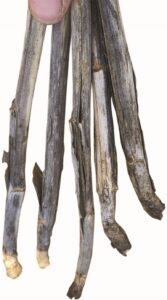New verticillium committee to guide agronomy and research
 Verticillium stripe is a relatively new disease to Western Canada. Since it was first found in Manitoba in 2014, it has slowly grown to be one of Manitoba’s more problematic diseases and is moving west across the Prairies.
Verticillium stripe is a relatively new disease to Western Canada. Since it was first found in Manitoba in 2014, it has slowly grown to be one of Manitoba’s more problematic diseases and is moving west across the Prairies.
Caused by the fungus Verticillium longisporum, the disease starts to present itself close to harvest timing with various symptoms such as half stem senescence, shredding of the stem tissue, a greyish-hue starburst pattern at the stem base when a cross section is taken and, finally, with the presence of microsclerotia. The disease can have an intense impact on yield when the conditions are right.
Surveying efforts have been more consistent since 2018 and results show that infection has spread from isolated pockets in Manitoba to all across Manitoba and now Saskatchewan and Alberta. After four growing seasons where verticillium infection levels have increased and spread significantly, the Canadian canola industry wants to know how much this disease affects yield and quality across the growing region and have more conversations on gaps in our knowledge and what research needs to be done.
A couple of research gaps, as noted at the workshop, are understanding the disease lineage, identifying the diseases impact on yield and further exploring control options.
While research efforts have been ongoing since the arrival of V. longisporum, the Canola Council of Canada (CCC) felt it was time to bring the industry together to discuss the disease and establish some collective direction. On December 4, 2023, on the eve of Canola Week, the CCC hosted a workshop for leaders in verticillium stripe research, testing and surveying. Workshop objectives were to bring the industry together, receive an overview of the 2023 growing season survey results, hear from the testing labs on what they saw for infection on samples submitted by producers and agronomists, review the latest research progress from the top verticillium stripe researchers across Western Canada, hear from the current working group on a rating scale and finally, to start developing a verticillium stripe steering committee.
Workshop discussions included observations from 2023, challenges producers faced when it came to combatting verticillium stripe, ongoing research and research priorities and gaps.
To help with verticillium stripe scouting in 2024, read the “How to identify verticillium stripe” fundamentals article here.
A couple of research gaps, as noted at the workshop, are understanding the disease lineage, identifying the diseases impact on yield and further exploring control options. In addition, understanding the interaction between verticillium and blackleg, and how or if current harvest management practices are impacting infection levels are also on the list of current research priorities.
The steering committee, which will be established in early 2024, will lead the industry on key messaging surrounding the disease as well as updated research priorities for the 2024 growing season. The workshop and the steering committee bring us closer to solving the puzzle that is verticillium stripe.




